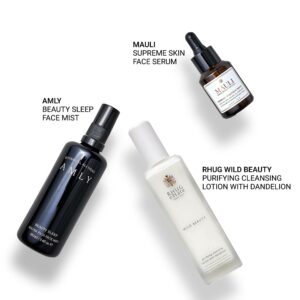Beauty Regime After Cancer


Cancer and its treatment can have quite a drastic effect on all aspects of life; from physical strength, to emotional wellbeing. Some side effects are well known, such as nausea, tiredness and hair loss; others are less widely documented, such as dry, painful skin and weakened nails. For a detailed review on the effects that chemotherapy can have on the skin, click here.
With all these changes happening, it is easy to forget the importance of following a good skincare routine. Looking after your face and body will not only help you to feel better emotionally, but can actually provide symptomatic relief and, with the right products, complement your treatment regime.
In this article we will look at those areas of the body that need some extra care and attention following cancer treatment; we will discuss what ingredients to look for in beauty products and offer some tips on how to improve your emotional wellbeing as well as easing physical discomfort.
The scalp
Hair loss is one of the better known (and most dreaded) side effects of chemotherapy treatment. Not everyone who undergoes treatment will lose their hair and, for those that do, it may be patchy, or thinning, rather than complete loss. The extent of loss will depend on the specific drugs used, dosage and individual susceptibility. For example, approximately 60% of those with breast cancer who are treated with taxanes, will experience hair loss or thinning; however platinum-containing drugs, including carboplatin and cisplatin, rarely cause hair loss. Hair loss can be restricted to the scalp, or can include body hair, eyelashes and eyebrows.
Prior to commencing treatment, discuss the likely side effects with a healthcare professional. If hair loss is predicted, consider cutting your hair shorter before treatment starts so that you can get used to shorter hair. Use a shampoo with gentle detangling properties, to avoid having to vigorously brush weakened hair. Consider whether you would prefer to wear wigs, hats or scarves, and turn shopping for these into a bonding experience that you can undertake with your husband or a close friend. If you are happy to leave your head uncovered do so, but take care to protect the delicate skin of the scalp from the elements. Use sunscreens rich in natural oils to protect against harmful UV rays. The Cancer Pack not only provides nourishment to the scalp through its cocktail of moisturising ingredients, it also contains Pro-vitamin B5, which seems to mitigate the effects of thinning hair.
Scalp cooling
Scalp cooling has been used by some patients to reduce the extent of hair loss. A cool cap is applied to the head, chilling the area and reducing blood flow, meaning that less drug reaches the hair follicles. This technique cannot be used for all cancer types.
Fortunately, most cases of chemotherapy-induced hair loss are temporary and once treatment ceases, hair will grow back. Whilst your hair grows back, continue to use products that encourage healthy growth and strength, so that the new hair is in optimal condition.
The skin
Dry skin is a very common side effect of a lot of chemotherapy drugs. Pre-existing conditions such as psoriasis and atopic dermatitis may be exacerbated by a weakening of the skin’s naturally occurring protective layer and even patients who have never suffered from sensitive skin before may become more vulnerable to dry, itchy skin. Cancer killing drugs work by attacking those cells in the body that are rapidly dividing; this rapid division is a fundamental property of cancer cells; however, other cells, including those that form the outer layer of the skin, also divide rapidly and thus are susceptible to the damaging effects of chemotherapy. Using products that are humectant-rich can bring soothing relief to dry, uncomfortable skin because they help to retain moisture in addition to providing a temporary barrier against environmental irritants.
As well as selecting the right skincare products, choose loose fitting, cotton clothing that is less likely to aggravate your skin. Avoid harsh detergents or fabric conditioners, which are known to trigger flare ups in those with sensitive skin. Take care when out in the sun as some chemotherapeutics can cause the skin to become particularly vulnerable to UV damage.
Nails
80% of people who receive taxane-based chemotherapy will experience detrimental nail changes. These changes can affect the nail matrix, the nail bed and/or the surrounding tissue of the nail, causing differences in the colour, the shape and the strength of the nails. Most frequently, nails become brittle, thin and develop ridges. Beau’s lines are a form of ridge that run side to side across the nail, forming deep grooved lines. They occur when normal matrix proliferation is interrupted, as happens during chemotherapy cycles. Oncholysis occurs when there is detachment of the nail from the nail bed; it often leads to haematomas and abscesses forming under the fingernails and toenails. If severe, oncholysis can lead to loss of the nail. Unfortunately the skin cells that make up the nail bed are prone to keratinisation (cornification) and scaling (subungal hyperkeratosis), so if nail loss does occur, care should be taken to ensure reattachment and regrowth, otherwise the damage may be irreparable.
The skin around the nails is at increased risk of becoming infected even when treatment is complete. This type of infection is known as paronychia and it causes pain, swelling, discharge and discoloured nails. Antibiotic treatment may be necessary to prevent symptoms from worsening.
Learn more…
The extent and severity of nail changes following chemotherapy can be reduced with cold therapy. Studies have found that when worn during treatment, frozen gloves and socks reduce the number of detrimental nail changes by between 80% (fingernails) and 100% (toenails).
One way of ensuring the long-term health of the nails during treatment and beyond, is to follow a careful nail care routine. Avoid harsh chemicals, including those used during a lot of manicures. Instead apply protective varnish and wear cotton gloves as required. Use emollient-rich moisturisers to prevent the skin around the nails from becoming dry and sore. Use a product such as the Cancer Pack which contains pro-Vitamin B5 to strengthen and fortify the nails. Keep nails short and neat and try not to bite them.
Hands and feet
During chemotherapy many patients develop hand-foot syndrome, also known as Palmar–plantar erythrodysesthesia. The symptoms can range from a tingling sensation in the fingers, palms and soles, to burning pain and blisters. It is not fully understood why it occurs following treatment, but it is likely that the skin cells are undergoing a cytotoxic reaction in response to the chemotherapy.
Prior to commencing treatment it may be worth taking prophylactic steps to enhance the skin barrier, using a high-quality moisturiser, such as the Cancer Selfcare Pack. This cream can then be used throughout treatment. Cold therapy has also been shown to be effective at alleviating some of the ill effects. Avoiding harsh chemicals is essential, but gentle foot massages with natural oils may provide some much needed respite.
Chemotherapy
Chemotherapy is an amazing tool for doctors to have at their disposal; current drugs are capable of extending survival, shrinking tumours, preventing metastasis and enabling people to live a life post-cancer. However, the impact that cancer and its treatment can have on a person’s quality of life should not be under-estimated. Whether it is the psychological effects caused by a change in appearance, or the physical burden of persistent itching; these factors need to be taken into account. Each person is different; how they respond, both emotionally and physically, to treatment will vary on an individual basis, as will the severity of side effects. Finding ways of coping with those elements of the treatment that are most unpleasant is fundamental to persevering with chemotherapy.
Sources:
- Gunnars, B, et al. “Assessment of Quality of Life During Chemotherapy.” Acta Oncologica, vol. 40, no. 2-3, 2001, pp. 175–184., doi:10.1080/02841860121325.
- Scotté, F, et al. “Matched Case-Control Phase 2 Study to Evaluate the Use of a Frozen Sock to Prevent Docetaxel-Induced Onycholysis and Cutaneous Toxicity of the Foot.” Cancer, vol. 112, no. 7, 1 Apr. 2008, pp. 1625–1631, doi:10.1002/cncr.23333.
- Scotté, F, et al. “Multicenter Study of a Frozen Glove to Prevent Docetaxel-Induced Onycholysis and Cutaneous Toxicity of the Hand.” Journal of Clinical Oncology, vol. 23, no. 19, 1 July 2005, pp. 4424–4429., doi:10.1200/JCO.2005.15.651.
- Sibaud, V, et al. “Dermatological Adverse Events with Taxane Chemotherapy.” European Journal of Dermatology, vol. 26, no. 5, 1 Oct. 2016, pp. 427–443., doi:10.1684/ejd.2016.2833.
- Sibaud, V, et al. “HFS-14, a Specific Quality of Life Scale Developed for Patients Suffering from Hand–Foot Syndrome.” Oncologist, vol. 16, no. 10, Oct. 2011, pp. 1469–1478., doi:10.1634/theoncologist.2011-0033.
- Spaich, S, et al. “Patient Preferences Regarding Chemotherapy in Metastatic Breast Cancer-A Conjoint Analysis for Common Taxanes.” Frontiers in Oncology, vol. 8, 21 Nov. 2018, p. 535., doi:10.3389/fonc.2018.00535.
- Young, A, and A Arif. “The Use of Scalp Cooling for Chemotherapy-Induced Hair Loss.” British Journal of Nursing, vol. 25, no. 10, 2016, pp. S24–S27., doi:10.12968/bjon.2016.25.10.S22.
- “Hair Loss, Hair Thinning and Cancer Drugs.” Cancer Research UK, www.cancerresearchuk.org/about-cancer/cancer-in-general/treatment/cancer-drugs/side-effects/hair-loss-and-thinning. Last reviewed: 13 Sep 2017.













































